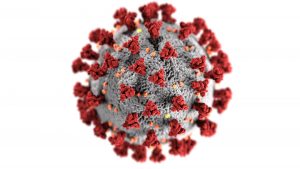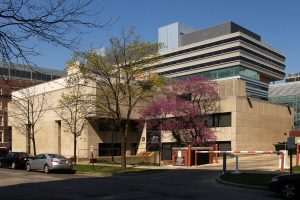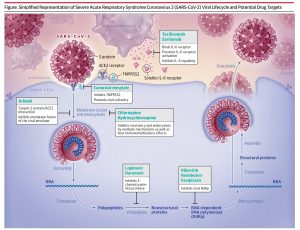Making the Connection – a New Virus

When we say the virus that causes COVID19 (the SARS-CoV2 virus) is novel, it means that human beings have never seen the virus before. So there is no “natural” immunity. This means every human on the planet can be infected. This virus is, to humans – new or novel. I know, the novelty feels as if it has worn off.
Where Did This Virus Come From?
But this virus was not just spontaneously generated, or created by some super alien to mess with planet earth? Well we have some pretty good data to talk about how it made the jump.
The SARS-CoV-2 virus is the seventh coronavirus that has infected human beings. The other two coronavirus that cause considerable misery include the original SARS virus and the MERS virus (SARS-CoV and MERS-CoV). The original SARS virus has not been seen since 2004, but is responsible for over 750 deaths. The original SARS virus came through has been traced through cave bats and civets. This virus gets a lot of press, since it caused quite a bit of concern in the United States. Taiwan suffered from this virus and as such were prepared for the current SARS-CoV2 outbreak.
The MERS (Middle Eastern Respiratory Syndrome Coronavirus) has been responsible for 858 deaths as of November of 2019. This coronavirus was first identified in Saudi Arabia in 2012. While most of the cases of MERS have been from other humans, the reservoir of this virus appears to be camels.
The other four coronavirus that infect humans cause mild symptoms, like the “common cold” and most often affect children.
Some people think the virus escaped form a lab in the city of WuHan. Could the people in WuHan that were working on bat virus lost one? It is possible but not probably. It is the probable favorite theory of people who love conspiracies, but it is quite unlikely. I will explain more in a bit.
The likely laboratory this came from was mother nature. Mother Nature has its own laboratory, we call it nature. Did you know that most virus that infect human beings came from other animals? It is true. Most virus, like measles, infected animals and then made the jump from animals to humans.

Kovler Viral Oncology Labs at The University of Chicago
We do not have the ability to engineer a virus to go from bat to human. How do I know? I spent several years working on molecular engineering of a virus at The University of Chicago. So playing with virus DNA is a part of my background.
We just don’t have the ability to make a virus that would go from a bat to a human. That is highly advanced, but someday possible. If we had that ability we would also have the ability to immediately create an antibody to that virus- and clearly we do not. So in spite of some conspiracy theorists thinking that “the Chinese created this,” there is no one on the planet that has that ability. Besides why would any country create a virus that infects your people and crashes your economy. That won’t stop people from wondering. But be assured – as of today human beings cannot make a virus go from one species to another. But lets talk about how that a virus can do that.
What about a lab accident? In this theory the bat virus infected a person who was working on it and that became patient zero. There is precedence for this. The virus that caused the original SARS outbreak was being studied in several labs and in 2004, that SARS virus was accidentally leaked from a facility in Beijing, infecting nine people and killing one. The difference is that the SARS virus was known, and being studied throughout the world.
The SARS-CoV2 virus is new, novel, and it has been sequenced. None of the viral sequences that the laboratory was working on in Wuhan match the SARS-CoV2 virus that is causing the pandemic. Every large city has a virology lab – and WuHan is a city that is larger than New York City. Shi Zhengli, a highly respected scientist who also works at the viral institute in WuHan and who has studied bat coronaviruses, said in February that she could “guarantee on my life” that the novel coronavirus did not come from the lab.
Genetic Anatomy of the Virus
We have the ability to look at the genetic material of the virus, convert it from RNA to DNA and sequence that genome. In fact, this was done very early in the course of the current infection. We not only know the parent SARS-CoV2 virus, but as it has been passed about from one person to another have identified its progeny that have other viral sequences (we know every base pair of this virus). From the WuHan laboratory, there are other corona viruses that they have studied the genetic material of, and there is a lot of genetic variation of a number of coronaviruses that came from bats.
Basic Virology
A virus is not a living entity. It is a just some genetic material that has a coat and the virus gains entry to a certain type of cell. When most virus enter the cell they take over the machinery of the cell and now that cell makes lots of new virus. So many copies of the SARS-CoV 2 virus, in fact causes the cell to explode. Some virus don’t do that- like HIV- that virus incorporates into the cell.
Bacteria have viruses so do plants, and so does every species (every animal on Noah’s arc had its own set of viruses). But the virus is species specific – a plant virus does not infect human cells. I suppose it is possible for a plant virus to infect a human cell- which would cause much distress among ardent vegans.
So how does a virus enter a body.
A virus can only invade your body by going into a specific cell type that has a specific receptor (think of it like a lock) that can be opened by a protein on the surface of the virus (think of this as a key) . The SARS-Cov2 virus infects certain lung cells, and other cells in the nose and the mouth. It cannot infect a skin cell, and if the virus is on your hand then the viral particle will degrade over time. If it has not degraded and your hand touches your mouth or your nose and the virus now can bind to a cell that has the ability to be infected. The virus fools the host cell into thinking it is a friendly protein and the cells let the virus in.
A virus cannot just “enter” a cell. To enter a cell the virus has to have the protein that unlocks the cell protein which allows entry. Just like our lock and key we talked about. The cell surface is intact, door is locked, so the virus has to unlock the door first. To do that the virus needs to have the right cell surface protein that allows entry. If the virus the correct protein, than it acts like a key and the cell allows entry of that protein, letting the virus in. But if that key (virus protein) doesn’t fit, the cell does not open.
Kind of like the horror movie where someone is going to open the door and they are bad people. But if they have the key they can enter the house and then they can steal things or do harm. Because once the virus enters the cell, the virus takes over the cell to make thousands of copies of the virus. It is the ultimate invader – it takes over your house.
How does a virus get the right key? And what keys fit?
A bat cell, for example, has a different set of locks than a human cell. So most virus that infect bats cannot infect humans. Those bat virus keys do not fit into the lock of the human cell. So how did this one change?
Mutating the key

When keys are made some will fit new locks they were not originally intended for
Have you ever had the frustration of getting a copy of a key made and then you discover that the keys just doesn’t work. You can jiggle it, you can play with it, but when it goes into the lock and you try to turn it- nothing happens.
But turn the original key into the lock – and it is smooth, goes in easily, and with a simple turn the lock opens up.
Make lots of copies of keys and you will have some that don’t fit, but you also might make a key that fits another lock.
When a virus takes over a cell it makes thousands of copies of itself. Little virus particles that are just bits of genetic material surrounded by a coat. The coat, or membrane, has little bits of protein on it, and those proteins are the keys. In making those thousands of copies of virus it will make a lot of copies that are not perfect. This protein is encoded for by the viral genetic material, and that genetic material has the most variability when studied. Mostly the virus is efficient at making exact copies. But there is enough variability that some of those viral particles won’t fit into the locks and those virus are not effective. But every now and then a virus will make another mistake and all of a sudden that key is like a master key – it can fit in a lot of locks
The same thing with the viral surface proteins that interact with cell surface proteins. Viral proteins are the keys. And in this context the virus made a key that not only fit the proteins found in the bat. But the proteins found in a human.
Who knows how long the bat virus had the ability to enter a human cell, or as we say, “make the jump to humans.” It could have been for years. It was just some unlucky human that got close enough to a bat sneeze. It turns out that bats are infected with a lot of types of coronavirus, probably the original SARS came from bats.
To get further into this, that receptor binding protein (the key of the virus) have six proteins on them that are critical for the virus to be able to bind to the host cell – and in this case the protein on the host cell is the ACE2 receptors. It turns out that the receptor binding protein on the SARS-CoV2 virus not only binds to human cells that have the ACE2 receptor, but also ferrets, cats (from domestic house cats to tigers), and perhaps even to canines (dogs). When studied the scientist came to the conclusion that the ability of the virus to bind to humans was random, and it was natural selection. By natural selection, the right virus found the right human and began to multiply.
But that original SARS-CoV2 bat virus came into contact with a human and that one single human started this mess. Could it have been a lab worker that was working with a bat virus? Yes, it could have. Could it have been someone who caught a bat and was going to eat it? Yes, it could have. Could it have been Batman, or maybe that bat-human Dracula? Well, however that jump from a bat to a human , it all started with just takes one human being.
Had that person stayed alone, overcame the COVID19 and never infected another person this epidemic would not have happened.
Why a Lab Didn’t Create This
Laboratories use known mechanisms to manipulate DNA of a virus. The vaccine being made, for example, comes off an adenovirus vector that has been manipulated to produce a lot of protein from the SARS-CoV2 virus. This isn’t new, it has been done before to make a vaccine for the MERS-CoV.
It turns out the receptor binding protein of the SARS-CoV2 virus is terribly efficient at binding to human cells, much more so than would be imagined. If genetic manipulation would have been responsible for this then they would have used a known coronavirus reverse transcriptase system that is widely used (we call this a backbone). The genetic evidence for this is clear – this did not come from one of the known backbones that are used for genetic manipulation.
Natural Selection – it isn’t just for Darwin -from bat to human
There are two possibilities that are commonly discussed among virologists. One is that natural selection for this occurred in another animal host before it made the transfer to humans. The bat virus could have found its way to a ferrel cat, a wild cat, a ferret, and it was that animal that made the close connection to a human being.
The second possibility is that it came from a bat – or maybe another animal.
The animal market in WuHan was linked to many cases of the original COVID19 infection. When the one bat coronavirus genetic material was examined (from the Rhinolophus affinis bat) it was 96% match. The issue is that the receptor binding protein of the SARS-CoV2 virus was different from this bat, and thus it would have mutated from this bat. Or it could be it was not this bat at all.
Another possibility has been the Pangolin, which is also infected with coronaviruses that are similar to the SARS-CoV2 virus. It turns out that the receptor binding protein of these virus are quite similar to the protein found in the SARS-CoV2 virus.
While both the bat and pangolin are the favorites, they do not contain the complete picture. Their genomes are not exact. But, there are a lot of native coronaviruses from both species that have not been studied.
What about having these many bat viruses available in tissue culture in the lab in Wuhan?
It turns out one of the parts of the virus that makes it so infectious isn’t only the ability of the virus to enter into human cells, but also the ability of the virus to have what are called polybasic cleavage sites. The generation of a SARS-CoV2 virus would require that a very closely similar virus would have been available and none have been found.
It appears that poly basic cleavage – the ability of using human enzymes to further allow entry into the cell, occurred once the virus made the jump to humans – and thus was a natural selection for the virus.
The Singularity of the SARS-CoV2 Virus
Of the different SARS-CoV2 viral genes that have been examined, they all point to a single parent virus that they have come from. One can further deduce from timing that this virus emerged in late November of 2019 to early December of 2019. In spite of the Hoover Institute of Stanford wishing the virus had been present months earlier, there is no evidence that this is the case. There are no earlier viruses that can be found that have this unique combination of that genetic material.
Why Do We Care Where This Came From?
If this came from an animal to a human then there is the possibility that this virus can continue to make those jumps from animal to human in the future. If the virus got to a human and by natural selection developed into this pandemic then it is far less likely that transfer from another animal back to humans will occur.
Since all the mutations that have been observed in the genetic sequence of other animal coronaviruses, both bat and pangolin, it is unlikely that this would have been made in a laboratory or spread from a laboratory.
The ability of having a well described genetic material not only assists in following the viral spread in epidemics, but those genetic sequences have been used for some of the potential vaccines that are currently being tested.
The Complexity of Viral Replication and Making Anti-virals

How a virus gains entry and what we can do from Journal of the American Medical Association (JAMA).
This was a simplified version of where this virus may have come and how the SARS-CoV2 virus works. Doctors and scientists use the methods of viral replication to develop antiviral drugs. As you can see in this graph from the Journal of the American Medical Association, there are a lot of drugs under consideration. Most of them won’t work.
Other Mutations
Besides the ability of a virus to infect cells there are other mutations that a virus can undergo. Some viruses are far more dangerous than others. But some viruses cause little disease. This is called attenuation. This is the process where a virus becomes less virulent to the host. Polio, for example, is a live virus vaccine, but it has been attenuated so that the virus does not cause severe illness. Every now and then that virus will mutate and become more dangerous to people.
Could that happen to SARS-CoV2? Yes. Could it be that some people just don’t get as ill because the virus is attenuated in some? Yes, and some have suggested that the virus on the East Coast is more dangerous than the virus in California. Although both are pretty bad.
Novel Virus
Believe it or not the CDC and World Health Organizations monitor different parts of the world for novel viruses. The first goal is to contain the virus, isolate the people who are infected and all those in contact with them. If that works we can stop those virus from becoming the pandemic that this has become. The second tool is called mitigation – keep everyone isolated – because without people the virus cannot survive. It can be infective on surfaces for a bit, but if it runs out of people, the virus goes away. This virus is out and about.
REFERENCES:
Qian Z1, Travanty EA, Oko L, Edeen K, Berglund A, Wang J, Ito Y, Holmes KV, Mason RJ. Innate immune response of human alveolar type II cells infected with severe acute respiratory syndrome-coronavirus. J Respir Cell Mol Biol. 2013 Jun;48(6):742-8. doi: 10.1165/rcmb.2012-0339OC.
Andersen, K.G., Rambaut, A., Lipkin, W.I. et al. The proximal origin of SARS-CoV-2. Nat Med 26, 450–452 (2020). https://doi.org/10.1038/s41591-020-0820-9
Zhou, P. et al. Nature https://doi.org/10.1038/s41586-020-2012-7 (2020).
